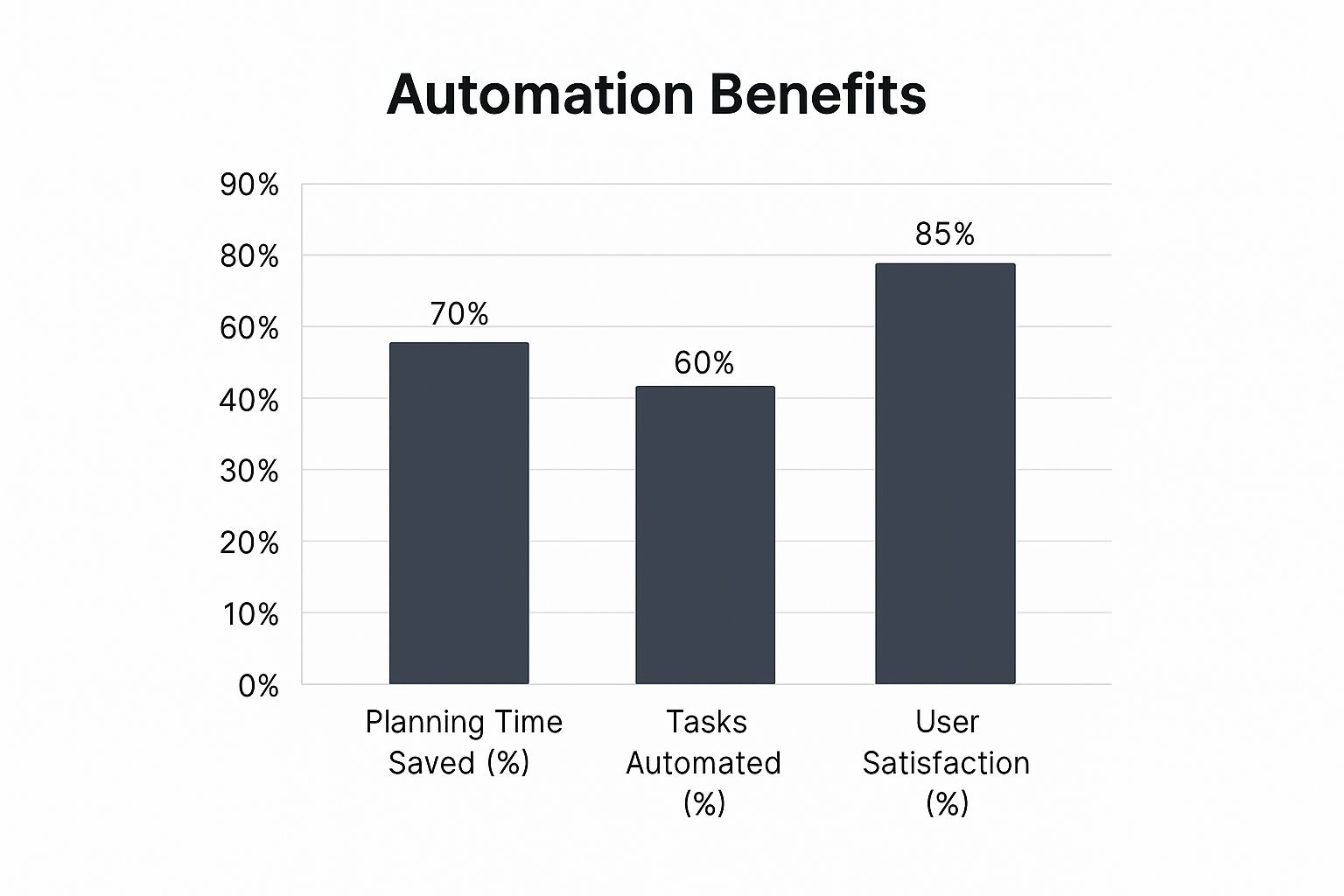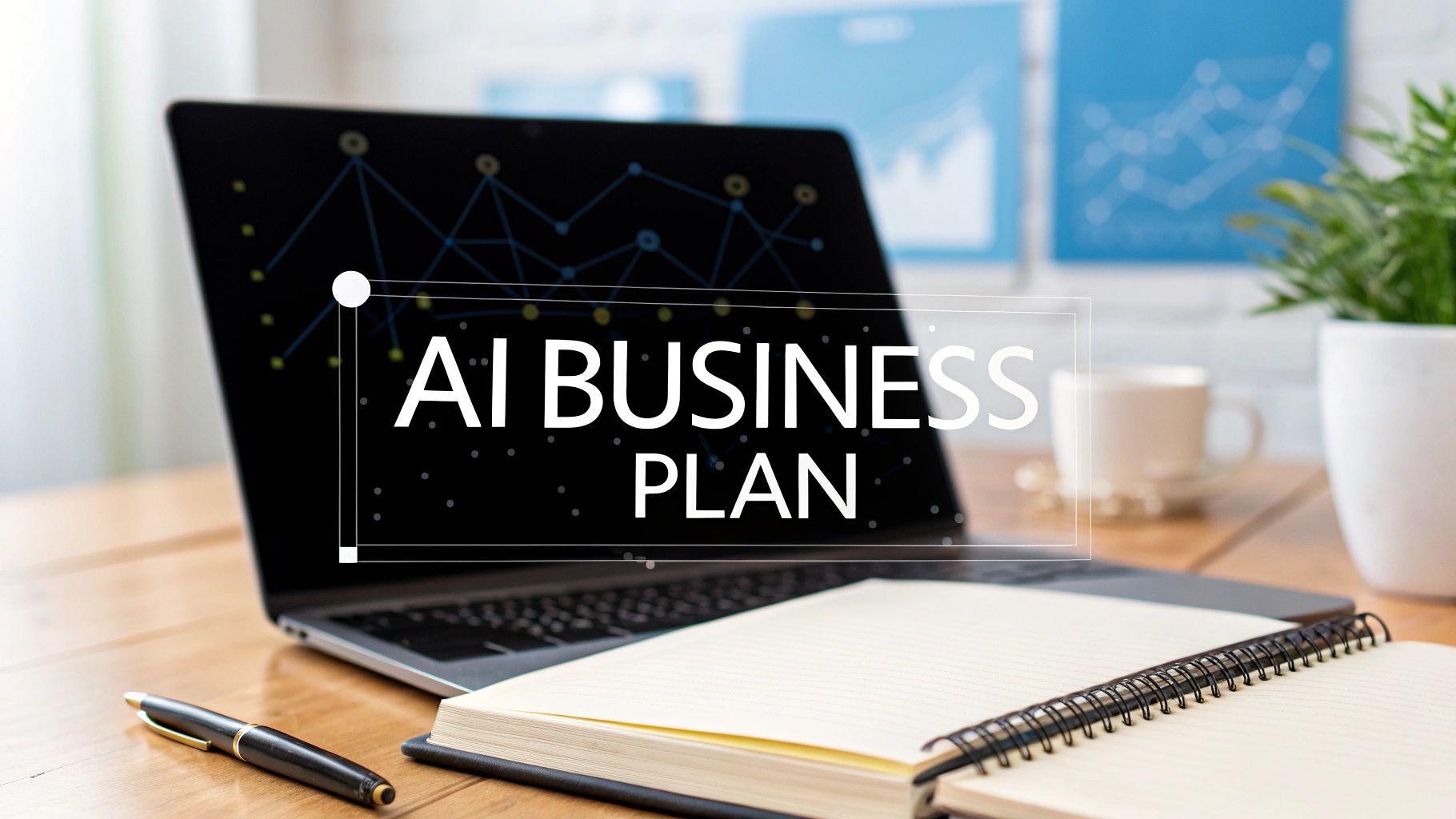Absolutely, you can create a business plan with AI. For many small business owners and solo entrepreneurs, this isn't just a small step forward—it's a complete game-changer. Using AI turns business planning from a chore you dread into a live, data-backed process that takes a fraction of the time.
The New Blueprint: How AI Transforms Business Planning
We’ve all been there. Staring at a blank business plan template, feeling that familiar wave of anxiety. For a small business, the old way of doing things is slow, can get expensive if you hire help, and often feels completely out of sync with the speed of actually starting a company. AI tools are rewriting that entire script.
Instead of dedicating weeks to tedious research, a small entrepreneur can now get a deep market analysis in a matter of minutes. This lets you move quicker and make smarter decisions based on real data, not just gut feelings. The idea isn't to let a machine replace your vision, but to give your vision a powerful assistant to do all the heavy lifting for your business model.
From Static Document to Dynamic Strategy
The real magic of using AI is that your business plan stops being a static document you create once and then file away. It becomes a living, breathing strategy tool.
You can instantly model different financial outcomes, test out various marketing messages, or pivot your entire strategy when the market throws you a curveball. For a small business, that kind of agility is a massive competitive advantage.
This infographic really drives home the point, showing the huge efficiency boosts entrepreneurs get when they use AI for their business planning—saving time, automating tasks, and just feeling better about the whole process.

As you can see, AI doesn't just speed things up. It makes the experience of planning your business more productive and, frankly, a lot less painful for a small business owner.
To give you a clearer picture of this shift, let's break down how AI tools specifically upgrade each part of a business plan.
AI's Role in Modern Business Planning
| Business Plan Section | Traditional Method | AI-Powered Method for Small Business |
|---|---|---|
| Executive Summary | Writing it last after hours of summarizing. | Instant generation based on completed sections. |
| Market Analysis | Weeks of manual research, sifting through reports. | Real-time data analysis and trend identification. |
| Competitive Analysis | Manually tracking a few known competitors. | Comprehensive scan of the local and digital market. |
| Financial Projections | Complex spreadsheets, prone to human error. | Dynamic modeling with multiple scenarios in minutes. |
| Marketing Plan | Brainstorming sessions and educated guesses. | Data-driven suggestions for channels and messaging. |
This table makes it clear: AI isn't just about writing faster; it's about building a smarter, more resilient business model from the ground up.
Embracing an AI Co-Pilot
The best way to think about this is to see AI as your strategic co-pilot. It crunches the numbers and drafts the sections, but your job as the small business owner becomes even more important. You’re the one who brings the unique idea, the industry experience, and the human touch that makes the plan convincing.
Treat AI as your collaborator. It lays the foundation with data and structure; you bring the story and the soul. That partnership is what makes a business plan truly compelling.
This new dynamic allows a solo founder or a small team to produce documents that are on par with those from massive corporations with their own strategy departments. The economic shift is huge. In 2025, the global AI market is projected to be worth around $391 billion, which shows how central this technology has become. It's no surprise that 83% of companies say AI is a top priority in their business strategy. This isn't a trend; it's the new standard for entrepreneurs.
For a deeper dive into these trends, Exploding Topics offers some fantastic insights. And if you’re ready to jump in and start building right now, our GrowthGrid AI Business Plan Starter Pack has all the tools you need to get going.
Building Your Custom AI Planning Toolkit

Before you jump into writing, you need to gather your tools. Crafting a business plan with AI isn't about finding one magic "do-it-all" button. It's about assembling a small, powerful toolkit—your "stack"—that actually fits your needs and budget as a small entrepreneur.
Think of it like building a workshop. You need a hammer for the big structural pieces, a precision screwdriver for the fine details, and a measuring tape to make sure everything lines up.
For a small business owner, this mix-and-match approach is a game-changer. It saves a ton of money and frankly, gets you a better result. You're not stuck with one expensive, oversized platform. Instead, you can pick the best tool for each part of the job, from brainstorming your initial business model to digging deep into market data.
The Three Core Tool Types
Your AI toolkit really boils down to three main categories. Each one plays a unique role, and when you put them together, you get a system that covers all your bases.
-
General-Purpose AI Chatbots: These are your creative partners and brainstorming buddies. Tools like ChatGPT or Google Gemini are fantastic for getting ideas out of your head, drafting the first version of a mission statement, or just breaking through writer's block. They're built to generate text and explore different angles for your business model.
-
Specialized Business Plan Generators: This is where you get your structure. Platforms like LivePlan or GrowthGrid give you the guardrails your plan needs. They walk you through every required section, often provide templates for specific industries (perfect for small businesses), and usually have built-in financial forecasting tools. This makes sure you don't overlook any crucial components.
-
Data and Market Analysis Tools: A business plan without hard data is just a dream. This is where tools such as Semrush or Ahrefs come in. They use AI to see what your competitors are doing, spot trends in the market, and find out what your potential customers are actually searching for. This is how you get the real numbers to back up your vision.
This combination is quickly becoming the standard for agile startups and small businesses for a reason. In fact, generative AI adoption among US small businesses is expected to jump from 40% in early 2024 to 58% by mid-2025. As research from the U.S. Chamber of Commerce shows, these tools are becoming essential for keeping up.
How to Choose Your Tools
So, how do you pick the right tools for your stack? Don't just go with the most popular name. Focus on what actually works for you and your small business.
- Ease of Use: How fast can you get something useful out of it? Your time is your most valuable asset as an entrepreneur, so a tool with a massive learning curve is a huge liability.
- Cost vs. Value: Most of these tools have free versions or trial periods. Start there. See if the insights you're getting are worth the monthly subscription for a small business on a tight budget.
- Quality of Output: Is the tool giving you specific, actionable information, or is it just spitting out generic fluff? Test each one with a small piece of your plan to see what the quality is like firsthand.
A huge mistake I see small entrepreneurs make is trying to use one tool for everything. A general AI chatbot can't do a detailed SEO analysis, and a data tool won't help you write a compelling origin story. The real power comes from using each tool for what it does best.
Putting together a simple but effective AI stack is your first real step. But before you even start writing, you have to be sure your core business model is solid. A great next step is to run it through an initial validation process. Check out our guide on conducting an AI-assisted feasibility study to make sure your concept is viable from the get-go. This way, you know you're building your plan on a strong, data-backed foundation.
Using AI to Define Your Business Core

This is where the rubber meets the road. Your vision starts becoming a tangible plan when you tackle the core sections: the Executive Summary, Company Description, and Mission Statement. For a small business, these aren't just formalities; they set the entire tone for your business plan. Getting them right is critical.
The secret isn't just telling an AI to "write a company description." That’s how you end up with generic, cookie-cutter text that nobody remembers. As a small entrepreneur, you need to get specific and feed the AI rich context. Think of yourself as the director and the AI as a talented but unguided actor—it needs your detailed script to give a great performance.
Crafting a Compelling Executive Summary
Here’s a pro tip that sounds counterintuitive: always write your Executive Summary last. It’s a summary, after all. But you can—and should—use AI right at the beginning to sketch out what its key components will be. This gives you a roadmap for the rest of the plan.
Treat your prompt like a creative brief. Don't just make a request; assign the AI a role and give it a detailed scenario to work with. I’ve found prompts structured this way get fantastic results for small business models:
"Act as a small business advisor. I'm launching an online subscription box for eco-friendly pet products, and my target audience is environmentally conscious millennials. Generate three distinct versions of an executive summary. Each version must highlight our unique value proposition: we partner with local artisans to source handmade, sustainable toys."
This prompt is powerful because it does three things: it sets a professional tone, provides very specific business context, and asks for variations you can cherry-pick from. The AI now understands not just what to write, but why it's important.
Defining Your Company and Mission
When you move on to your Company Description and Mission Statement, the approach is similar, but the focus shifts to your brand’s soul. These sections are your chance to tell a story and plant your flag. You can’t afford to let an AI’s generic language water that down.
Use the AI to brainstorm and organize your ideas, but make sure the final version sounds like it came from you, the entrepreneur.
- For the Company Description: "My business is a mobile coffee cart in the downtown business district specializing in single-origin pour-overs. Write a company description that feels friendly, artisanal, and community-focused. Make sure to emphasize our commitment to sourcing beans directly from fair-trade farms."
- For the Mission Statement: "Generate five mission statement options for a small, independent bookstore. Our core values are promoting local authors, creating an inclusive community space, and fostering a lifelong love of reading. The tone should be concise but inspiring."
This is how you create a business plan with AI that still has a human touch. And when it comes to the numbers, AI can also help organize the financial projections and statements that underpin your narrative. If you’re building from the ground up, it helps to understand the fundamentals of how to prepare financial statements from scratch.
The last step is crucial: review and personalize. Read the AI's output out loud. Does it sound like your business? Tweak the wording, inject a personal anecdote, and make sure your authentic voice is unmistakable. This simple act transforms a well-structured document into a powerful story that will resonate with anyone who reads it.
Uncovering Market Insights with AI
Market analysis is where so many small entrepreneurs get stuck. It feels like this massive, intimidating mountain of research. But honestly, this is where AI can give a small business an almost unfair advantage. Instead of spending weeks drowning in reports, you can pull out genuinely deep insights in a couple of hours.
It all starts with getting crystal clear on who you're selling to. Most people guess, but with AI, you can build a customer persona that’s incredibly detailed. We're talking about moving past simple demographics and getting into the psychographics—what your customers actually believe, what drives them, and why they buy.
Pinpointing Your Ideal Customer and Market Size
A well-crafted AI prompt is like a cheat code for understanding your audience. The key is to get specific; don't just ask a generic question. Give the AI real context about your business.
Let’s say you’re launching a subscription service for high-quality dog food. You could check out a complete sample business plan for an online dog food store to see the kind of detail you need, and then craft a prompt to get you there.
Try something like this:
"Act as a market research analyst for a small e-commerce business. My business is a premium, subscription-based dog food service in Austin, Texas, using only locally sourced, organic ingredients. Create a detailed ideal customer profile, including their demographics (age, income, location) and psychographics (values, lifestyle, online habits, pain points related to pet care)."
Once you have this profile, sizing up your market becomes a whole lot easier. An AI can comb through local data and give you a realistic estimate of your potential customer base. This isn't just a vanity metric; it's a crucial number for proving your business model is viable, both to yourself and to any lender or investor.
Decoding the Competitive Landscape
Alright, you know your customer. Now, who else is trying to sell to them? AI is brilliant at not only spotting your direct competitors but also digging up the indirect ones you might never have thought of. This is a non-negotiable step when you create a business plan with AI, as it's how you carve out your own space.
You can give an AI a list of companies you know about and have it run a full SWOT analysis (Strengths, Weaknesses, Opportunities, Threats) on them. Suddenly, you've got a breakdown of their marketing strategies, what their customers are complaining about online, and how they price their products. Those are the gaps where your business can shine.
Here’s a prompt to get you started:
"Analyze the top three direct competitors for a local, eco-friendly house cleaning service in Portland, Oregon. Identify their primary marketing channels, common customer reviews (positive and negative), and pricing structures. Based on this, suggest three market gaps my new small business could fill."
This turns competitor research from a boring task into a powerful strategic weapon. The real magic of AI is its ability to process a staggering amount of data. A Q1 2025 survey showed that 53% of organizations are already using AI to make sense of big data for strategic planning. You're essentially getting the power of a data science team in a chatbot.
If you want to dig deeper into that trend, you can read the full research about AI and big data from IDC. And for a more niche example, reports like the AI in Sports Market Research Report show just how much AI is changing specific industries, which can spark some great ideas for your own venture.
Crafting Your Marketing and Sales Strategy

A brilliant idea and a solid plan are a great start, but they won't pay the bills if nobody knows you exist. This section is all about building the engine that drives your business forward: your marketing plan. For a small business, this can feel like the most intimidating part, but it's another area where AI can help you punch well above your weight.
You don't need a massive marketing department or a bottomless budget to make an impact. What you do need is a smart, focused marketing plan that speaks directly to the customers you identified earlier. This is how you create a business plan with AI that turns into real-world action and, most importantly, revenue.
Figuring Out Your Go-To-Market Plan
First things first, you need to bridge the gap between who your customers are and how you're actually going to reach them. An AI tool is the perfect brainstorming partner for this. You can give it your ideal customer profile and ask it to spit out a list of the most effective channels to connect with that specific audience.
For instance, a prompt like this can get the ball rolling on your entire marketing plan:
"Act as a marketing strategist for a small, independent coffee shop targeting young professionals and university students. Suggest the top five marketing channels to reach this demographic, explaining the pros and cons of each. Include ideas for Instagram, TikTok, and a local community partnership."
Just like that, you get a clear, prioritized list of where to focus your precious time and money. Instead of throwing things at the wall to see what sticks, you get a data-informed starting point built around your unique business model.
Building a Practical Content and Sales Engine
Once you know where to show up, you need to figure out what to say. This is where you can lean on AI to build a content calendar that actually attracts and engages your audience, turning them from passive observers into paying customers.
Think about a small, bootstrapped business—creating content consistently is a huge struggle. But with AI, you can outline an entire quarter's worth of content in less than an hour.
- Blog Topics: Ask for a list of blog post ideas that solve your target customer’s biggest headaches.
- Social Media Themes: Generate weekly themes for Instagram or Facebook to keep your content focused and fresh.
- Email Sequences: Have it write a simple three-part welcome email sequence for new subscribers.
Here’s a more detailed prompt to show you what's possible for your marketing plan:
"Create a 3-month content marketing plan for a new e-commerce store selling handmade leather wallets. Our target audience is men aged 25-45 who value craftsmanship. Suggest four blog topics, a weekly Instagram theme for each month, and a welcome email sequence for new newsletter sign-ups."
The output you get becomes your roadmap. You can then use these content ideas to build out your sales funnels, mapping out the journey a person takes from seeing a social media post to clicking "buy" on your website. This structured approach, powered by AI, ensures your marketing efforts feel cohesive and professional and are actually designed to drive sales from day one. Your plan stops being just a document; it becomes your playbook for growth.
Common Questions About AI Business Planning
As you start working with AI to map out your business, a few questions always seem to come up. It's a big shift from the old way of doing things, and it's smart to get a feel for the new terrain before you jump in. Let's dig into some of the most common things small entrepreneurs wonder about.
Can I Actually Get Funding with an AI-Generated Business Plan?
Yes, but there’s a crucial catch. An AI-generated plan can give you an incredibly professional, data-rich foundation that will absolutely catch the eye of investors and lenders. It proves you've done your homework.
But here’s the thing: investors fund the entrepreneur, not just the document.
You have to own every single word and number in that plan. Be ready to defend your financial projections, explain your marketing strategy in your own voice, and—most importantly—let your passion for the business shine through. Think of the AI as your co-pilot, handling the analytics and the first draft. You're still the one flying the plane and selling the destination.
What Are the Biggest Mistakes People Make?
Using AI for business planning is pretty straightforward, but a few common pitfalls can easily trip you up. Knowing what they are from the get-go will save you a ton of frustration later.
Here are the top three mistakes I see small business owners make all the time:
- Blindly Trusting the Output: Never, ever assume the AI's data is perfect. Always double-check critical numbers, like market size statistics and financial forecasts, against reputable sources. Treat the AI's output as a very strong starting point, not the final word.
- Forgetting Your Brand Voice: The raw text from an AI can sound generic. It's your job to go back through and inject your company's unique personality and story. That human touch is what turns a dry document into a compelling vision.
- Neglecting Your "Why": An AI is fantastic at explaining the "what" and the "how" of your business. But it can't capture your personal journey, your passion, or your grit. Your plan needs to scream why you are the person to make this happen.
The best AI-assisted business plans are true partnerships. The AI brings the structure, data, and speed; you bring the real-world validation, personality, and unwavering conviction.
Which Part of the Plan Gets the Biggest Boost from AI?
While AI helps across the board, two areas are completely transformed by it: Market Analysis and Financial Projections. Honestly, for most small entrepreneurs, these are the sections that cause the most headaches and take up the most time.
AI can crunch massive amounts of market data in minutes, identifying trends and competitor weaknesses that might take a human researcher weeks to find. And when it comes to the numbers, it can generate detailed sales forecasts, cash flow statements, and break-even analyses based on your inputs. This saves you countless hours wrestling with spreadsheets and seriously cuts down on the risk of simple human error. This is where AI goes from being a helpful tool to an absolute game-changer for a small business.
Ready to build a professional, data-driven business plan in minutes? GrowthGrid uses advanced AI to do the heavy lifting for you, saving you time and money so you can focus on launching your dream. Start your plan today.
